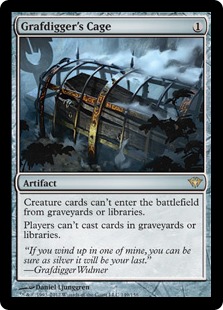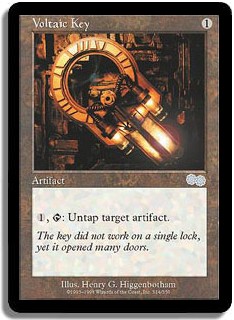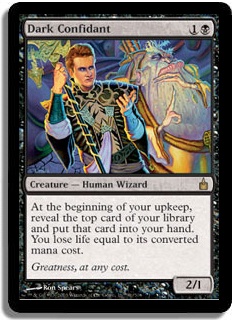Greetings and welcome back to Vintage Avant-Garde, where this week we’ll be discussing a pretty awesome current Vintage deck, Paul Mastriano Meandeck BUG Fish list. Paul recently made Top 8 at the Grudge Match tournament in New Jersey with the list, and he has told me that he felt the deck was the real deal and definitely worthy of an encore performance at future upcoming tournaments. If Paul is correct (which I assume he is, considering the deck looks sweet!), one would be wise to become familiar with the list, what the deck does, and understand how it works.
Creatures (12)
Planeswalkers (1)
Lands (15)
Spells (32)
- 1 Brainstorm
- 1 Vampiric Tutor
- 1 Mystical Tutor
- 1 Yawgmoth's Will
- 4 Force of Will
- 1 Sol Ring
- 1 Demonic Tutor
- 1 Hurkyl's Recall
- 1 Time Walk
- 1 Ancestral Recall
- 1 Mana Crypt
- 1 Time Vault
- 1 Merchant Scroll
- 1 Tinker
- 1 Voltaic Key
- 1 Black Lotus
- 1 Mox Emerald
- 1 Mox Jet
- 1 Mox Pearl
- 1 Mox Ruby
- 1 Mox Sapphire
- 1 Ponder
- 3 Preordain
- 2 Mental Misstep
- 2 Flusterstorm
Sideboard

After talking to Paul, he said that were he to play the deck again he would probably make the following changes: minus one Sower of Temptation to add one Trygon Predator into the main deck; this opens up one sideboard slot for something new—he said that he would add one Grafdigger’s Cage to the sideboard.
With the logistics of the decklist and possible tweaks and tunings, I’d like to discuss how exactly this deck works and what is noteworthy to know about this deck moving forward.
A Lot Of Plans = A Lot Of Routes To Victory
One noticeable attribute of the decks that tend to be performing well in the modern Vintage era is that they are notably versatile with regard to the multiplicity of paths a pilot can take to victory. Meandeck BUG is no exception to this rule, and in keeping with the tradition of a typical Paul Mastriano deck it utilizes all of the usual suspects: it has powerful game-ending combos this time Voltaic Key + Time Vault, as well as Tinker + Blightsteel Colossus. But in addition to simply trying to force its hand at going big or comboing out, MDBUG also has the ability to win via attacking with its cast of small, powerful, and efficiently casting cost creatures: Dark Confidant, Trygon Predator, and Tarmogoyf.
Last month I reported that Vintage was entering into the "age of the creature" in my article here. I believe that seeing decks like Meandeck BUG cropping up and performing very well pretty well justify this claim. The subsequent printing of Grafdigger’s Cage also furthers the agenda of for the first time bringing combat to the forefront of competitive Vintage play. If you notice, Paul’s deck is actually really well positioned to take as little splash damage as possible from players who try to put him in the Cage—which is probably a smart bet for the time being.
The only lines of play that an opposing Cage cut him off from are playing the card Yawgmoth’s Will and Tinkering specifically for a Blightteel Colossus—essentially, making opposing Cages into a Meddling Mage that names Will and won’t allow his Tinker to get BSC. Luckily, (or perhaps smartly), Paul includes the Time Vault + Voltaic Key combo for infinite turns as his combo route to victory, so even if Cage is deployed he can still have valuable Tinkers.
As the saying goes, "I got 99 problems but a cage ain’t one."
A Meddling Mage sans the "Mage" part…
The big innovation is that Paul has essentially loaded his deck with efficient creatures—a choice that has some pretty great effects with regard to how his matchups stack up. On the one hand, as I stated as my justification for building the Bant Midrange deck, playing with creatures allows a blue deck to essentially blank all of the best strategic cards that punish people for playing prototypical blue decks.
It’s so much easier to not have to worry about having to deal with these cards from opponents when one has access to a bunch of efficient creatures that simply ignore, perhaps even punish, an opponent for loading up on cards to win the Gush mirror match.
One of the big tendencies I’ve seen with regard to how decks matchup in Vintage is that "strategic trumps," because they have gotten better, more efficient, and much more relevant in Vintage, are of critical importance because when drawn and cast they provide a huge opportunity to dramatically swing games; this fact is doubly important in the blue-on-blue matchup. Resolving a turn 1 Mystic Remora with a couple Moxes can simply end a game all by itself, and the same is true about putting the cherry on top of a multi-spell counter war with the casual Flusterstorm or Mindbreak Trap.
Playing with the creature strategy as a supplemental route to victory devalues the traditional strategic trumps from the opponent and forces your opponent to take action (by putting them on a clock), making them play into your cards.
In non-blue matchups it also doesn’t hurt that the creatures utilized by the BUG list function as strategic trumps in many of the other important matchups.
For instance, Trygon Predator (which Paul played two but now advocates moving up to three with the fourth in the sideboard) is among the best strategic trumps in any available card type against artifact-heavy Mishra’s Workshop decks.
Also, against opposing creature decks the BUG deck has Tarmogoyfs, which are amazing at staying back on defense and stonewalling an opponent’s attacks with smaller, "fishier" creatures such as Thalia, Guardian of Thraben, Qasali Pridemage, and Noble Hierarch. Not to mention the fact that Paul also has a Sower of Temptation that he can Tutor for and slam down to dramatically swing the creature mirror match.
When one looks at the cards in the BUG list and begins to think about why they’re in the deck and how they function as individual units that comprise the entirety of a functioning deck, it becomes apparent that what is going on is that the deck is actually the most powerful and best positioned combos (Tinker, Yawgmoth’s Will, Blightsteel Colossus, Key + Vault), all of the best Tutors and library manipulation (restricted list blue and black cards, Preordain), a variety of relevant creature back-up plan to harass opponents with pressure (as well as dodge the effectiveness of typical anti-blue trumps), and a bunch of trumps of its own to brick other linear strategies. I really like decks like these in Vintage because they provide pilots with a lot of options and tend to reward choosing the correct route to victory (among the many available lines) because they don’t specifically force a player to play directly into an obverse tactical defense for lack of something better to do.
Matchup Objectives And Sideboarding Guide With Meandeck BUG
MUD
In game 1 against MUD the plan is going to be to combo them out by assembling either the infinite turn combo or hitting them with a Blightteel Colossus. However, the creature plan (particularly the Trygon Predator plan) supplements being able to combo out quite nicely. I like that this deck doesn’t rely on having to Hurkyl’s Recall and hopefully having the mana and resources to Gushbond immediately in order to win, but rather can defend itself with Tarmogoyfs and pick apart the opponent’s defenses with Trygon Predators. As always, staying in the game and continuing to develop mana and not get locked by cost increasing artifacts is of critical importance, since if you make it into the midgame with the ability to progress the board and play spells you’ll be very likely to end up victorious.
Sideboard Plan:
-2 Flusterstorm
-2 Mental Misstep
-1 Voltaic Key
-1 Time Vault
+3 Nature’s Claim
+1 Trygon Predator
+2 Dismember
After sideboard, because of the fact that BUG gets to bring in six cards that can very efficiently undo any kind of early tempo that MUD can apply, the strategy of creating an opportunity to combo and ending the game becomes less important. The plan after sideboard is to kill anything they create that walks, crawls, slithers, or flies and then beat them down with Trygons and Tarmogoyfs.
Blue Aggro Control
Infinite turns with the Time Vault combo really shines against these types of decks, and shoring up the matchup against decks that are better in the red zone is the number one reason that Key + Vault made it into this deck.
"That’s a pretty cute army you’ve assembled over there; do you mind if I just take all the turns?"
The key to the pre-sideboard games is to use creatures like Tarmogoyf or Trygon to hold down the fort long enough to let BUG’s more powerful "big blue" spells take over and bury the opposition. Depending upon the construction of the Fish deck, Blightsteel Colossus may or may not be an important and exploitable trump—however, be wary of playing too dramatically into their Swords to Plowshares, Steel Sabotages, or Jace, the Mind Sculptors and getting blown out. It’s usually a pretty good rule of thumb that if they can’t remove a Goyf or Trygon that is preventing them from pushing damage through that it may be a good time to risk a Tinker for BSC.
Sideboard Plan:
+2 Dismember
+1 Trygon Predator
-1 Hurkyl’s Recall
-2 Flusterstorm
Not a whole lot changes with regard to the dynamics of the matchup from game 1 into games 2 and 3. The plan to leverage your creatures long enough to execute your "big blue" strategy is still the plan. The key difference is that after sideboard BUG actually has a few removal spells instead of Flusterstorms and Hurkyl’s Recall, which are typically pretty dead. If the opposing aggro deck has Null Rods and Stony Silences or Stoneforge Mystic, don’t hesitate to sideboard out Merchant Scroll and Ponder to make room for a couple of Nature’s Claims.
Dredge
Paul’s Top 8 loss with Meandeck BUG was actually to Dredge, which I think that he fixed by adding the seventh anti-Dredge card to his sideboard.
In game 1 the plan absolutely, positively has to be to try and combo as quickly as possible, because it’s virtually the only way that game 1 can essentially be "stolen" from Dredge, which is the overwhelming statistical favorite pre-board.
Sideboard Plan:
+4 Leyline of the Void
+2 Yixlid Jailer
+1 Grafdigger’s Cage
-3 Trygon Predator
-1 Hurkyl’s Recall
-1 Sower of Temptation
-1 Tarmogoyf
The post-sideboard matchup is much improved and revolves around the tactic of getting one of BUG’s sideboard cards that prevents Dredge from going off and then protecting that card while trying to win. In particular, if you can sustain a Leyline or Jailer the next course of action is to sift, Tutor, draw cards, etc. in search of the fastest way to actually end the game. Post-sideboard games usually play out where the opponent is trying to remove one’s hate card and you’re trying to protect the hate card long enough to win the game. If you lose your deflector shield (Leyline, Jailer) too early it’s nigh impossible to race Dredge’s quickly assembled sprint to victory. When the shields go down you’re probably dead on their turn; if you’re lucky enough to not die, then you’re definitely dead on their subsequent turn.
So, SHIELDS UP!
Big Blue (Gush, Control)
In this matchup the key is to observe the three D’s: Deploy, Disrupt, and D’get In There (D is silent). Ideally, the way one should envision the game going is that on the first turn, if possible, the goal should be to get a creature into play—and then after that essentially the game plays out where you’re fighting the blue mirror except you’re harassing them with a critter every turn and forcing them to play into you. However, the cool thing about forcing them to play into you is that they can’t get properly positioned to defend against your powerful blue stuff either. The matches, therefore, become very tempo oriented, and on the bonus side the better prepared they think they are to fight off typical big blue decks, their technology for improving that matchup is likely to become a liability in the face of Tarmogoyf, Dark Confidant, and Trygon Predator.
Dark Confidant obviously shines in a world full of Flusterstorm, Mental Misstep, and Mystic Remora—he is the strategic trump for the modern blue mirror.
The secret is that Dark Confidant is the new/current key to unlocking the blue mirror. (Again.)
Sideboard Plan:
+2 Flusterstorm
-1 Sower of Temptation
-1 Trygon Predator
Having access to the full four Flusterstorms post-sideboard against Gush and other big blue variants seems like an absolute dream come true. The plan remains the same as in the first game, except now (with the full suite of FS) BUG can better afford to deploy a creature or two early and then sit back and play back at the opposition’s action. Flusterstorms are great because they simply mock the age-old adage of broken spell + Force of Will.
Thanks for reading everybody!
Cheers,
Brian DeMars




